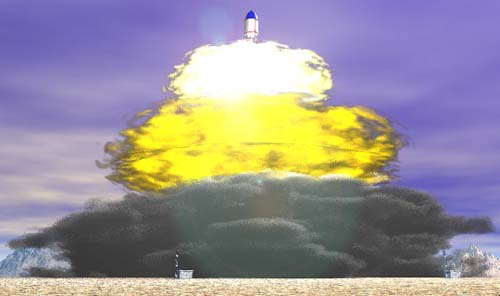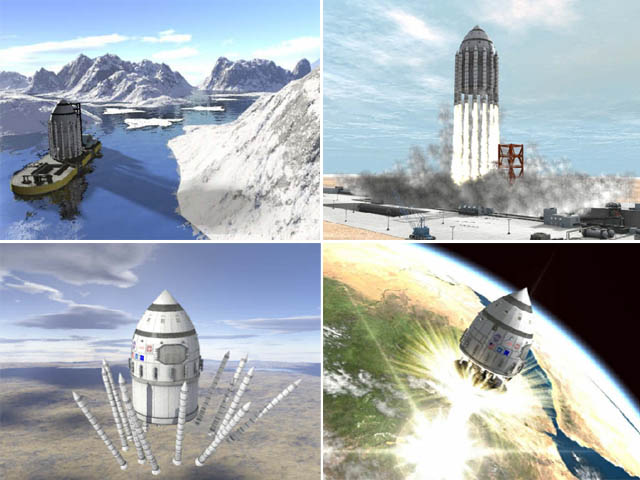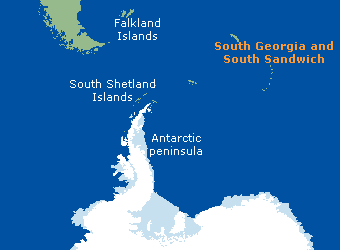
Thursday, July 30, 2009
BIG ENGINEERING 36 ORION PROJECT - CHEAPER TO ORBIT THAN AN ELEVATOR - MANKIND'S ULTIMATE DEFENCE AGAINST LARGE METEORS



If you put put a manhole cover on top of a nuclear bomb it passes escape velocity. So what happens if you put something the size of a destroyer on top of a rather larger manhole cover & use several Bombs?
From the Internet Encyclopedia of Science
"Project Orion examined the feasibility of building a nuclear-pulse rocket powered by nuclear fission. It was carried out by physicist Theodore Taylor and others over a seven-year period, beginning in 1958, with United States Air Force support. The propulsion system advocated for the Orion spacecraft was based on an idea first put forward by Stanislaw Ulam and Cornelius Everett in a classified paper in 1955....
The propellant and bomb were combined into a single pulse unit. Plastic was chosen as the propellant material, not only because of its effectiveness in absorbing the neutrons emitted by an atomic explosion but also because it breaks down into lightweight atoms such as those of hydrogen and carbon which move at high speed when hot. This approach, in tandem with the pusher plate concept, offered a unique propulsion system that could simultaneously produce high thrust with high exhaust velocity. The effective specific impulse could theoretically be as high as 10,000 to one million seconds. A series of abrupt jolts would be experienced by the pusher plate, so powerful that, if these forces were not spread out in time, they would result in acceleration surges that were intolerable for a manned vehicle. Consequently, a shock absorbing system was devised so that the impulse energy delivered to the plate could be stored and then gradually released to the vehicle as a whole...
Taylor and Dyson were convinced that chemical rockets, with their limited payloads and high cost, represented the wrong approach to space travel. Orion, they argued, was simple, capacious, and above all affordable. Taylor originally proposed that the vehicle be launched from the ground, probably from the nuclear test site at Jackass Flats, Nevada. Sixteen stories high, shaped like the tip of a bullet, and with a pusher plate 41 m in diameter, the spacecraft would have utilized a launch pad composed of eight towers, each 76 m high. Remarkably, most of the takeoff mass of about 10,000 tons would have gone into orbit. The bomb units ejected on takeoff at a rate of one per second would have yielded 0.1 kiloton; then, as the vehicle accelerated, the ejection rate would have slowed and the yield increased, until 20-kiloton bombs would have been exploding every 10 seconds...
There was no obvious technical flaw in the Orion scheme, nor any argument to suggest that it could not be implemented economically. Its huge weakness, however, was that it depended upon atomic explosions that would release potentially harmful radiation into the environment...
One of the missions suggested for this so-called first-generation Orion was a 125-day round trip to Mars, involving eight astronauts and around 100 tons of equipment and supplies. A great advantage of the nuclear-pulse method is that it offers so much energy that high-speed, low-fuel-economy routes become perfectly feasible...
Because Orion was classified, few people in the scientific and engineering community even knew it existed. They lobbied the Air Force to declassify at least the broad outline of the work. Eventually it agreed ... in October 1964. The Air Force, however, also indicated that it would be unwilling to continue its support unless NASA also contributed significant funds. Cash-strapped by the demands of Apollo, NASA announced publicly in January 1965 that no money would be forthcoming.
Freeman Dyson reflected that "this is the first time in modern history that a major expansion of human technology has been suppressed for political reasons." In 1968 he wrote a paper about nuclear pulse drives and even large starships that might be propelled in this way. But ultimately, the radiation hazard associated with the early ground-launch idea led him to become disillusioned with the idea. Even so, he argued that the most extensive flight program envisaged by Taylor and himself would have added no more than 1% to the atmospheric contamination then (c. 1960) being created by the weapons-testing of the major powers."
There is a quote by Freeman Dyson in the book that mentions a calculated 5 cents per pound of payload (at 1960s era prices) for a 1,000,000 ton ship powered by a few thousand megaton H-bombs.
Wikipedia says "Freeman Dyson, group leader on the project, estimated back in the '60s that with conventional nuclear weapons, that each launch would cause on average between 0.1 and 1 fatal cancers from the fallout. Danger to human life was not a reasons given for shelving the project (which included lack of mission requirement (no-one in the US Government could think of any reason to put thousands of tons of payload into orbit)"
I must admit to some surprise that, even back then, nobody in the US government could think of a reason to put thousands of tons in orbit. Must have been having a bad day. Apart from anything else a device that can put 4,000 tons in orbit can create a Moonbase in 1 trip, or a team to Mars. At the time the only theory about radioactivity was the LNT theory that there was no lower limit to damage caused but, though it is still politically correct the actual evidence has repeatedly supported the hormesis theory that below a certain level it is either safe or beneficial. Thus even the 0.1 cancers per launch now looks overcautious.
Next Big Future has done a number of articles on nuclear pulse rockets saying:
"The typical analysis of the nuclear Orion external pulse propulsion rocket is to use constant charges (bombs) every 1.1 seconds to launch with people inside who experience 4Gs or less.
Nuclear Orion can achieve launch costs of less than $1/kg and perhaps a tiny fraction of that. This is 1000 to 20,000 times cheaper than current costs."
& even
"Many have focused on the 40 meter diameter 4000 ton Orion but this is one concept that scales so well that the bigger (within reason) the better.
The Super-Orion we will consider here is the 8 million ton model. This alas is not 8 million tons to orbit but rather an extrapolation of the 4000-ton model—1/4 each payload, structure, pusher plate, and bomb units (fuel/reaction mass)
So in this case 2 million tons of each."
&
"Project Orion definitely made sense. It would be cheaper than the space elevator. The launch cost for the largest Orions was 5 cents per pound (11 cent/kg) to Earth orbit in 1958 dollars. In 2005 dollars, the cost would be 32 cents/lb or 70 cents."
"Our motto was 'Mars by 1965, Saturn by 1970'", recalls Dyson. Orion would have been more akin to the rocket ships of science fiction than to the cramped capsules of Gagarin and Glenn. One hundred and fifty people could have lived aboard in relative comfort; the useful payload would have been measured in thousands of tons. Orion would have been built like a battleship, with no need for the excruciating weight-saving measures adopted by chemically-propelled spacecraft. It is unclear how the vehicle would have landed; it is reasonable to assume that specialized chemically-powered craft would have been used for exploration. Taylor may have anticipated that a conventional Space Shuttle-type vehicle would have been available to transport people to and from orbit. Dyson gives the astounding figure of $100 million per year as the cost of the proposed twelve-year program (1964 costs) [nowadays a cost of $691/£450 million annually] Given that low-altitude orbital velocity is about 26,000 feet/second, around 350 pulses would be required (59). Using $500,000 as a reasonable pulse-unit cost, this implies a "fuel cost" of $175 million, cheaper than a Shuttle launch. Whereas the Shuttle might carry thirty tons of payload, the pulse vehicle would carry thousands. If one uses the extreme example of spending $5 billion to build a vehicle to lift 10,000 tons (or 20 million pounds) to orbit, the cost if spread over a single flight is $250 per pound, far cheaper than the accepted figure of $5,000 to $6,000 per pound for a Shuttle flight."

What stopped it then & today is clearly that it is atomic & anything with atoms in it stirs the media & the Luddites into a frenzy. When I started this series I said I would deal with political problems by ignoring them & mentioning just what is feasible. Nonetheless:
1 - The evidence is overwhelming that low level radiation is not a real, problem.
2 - Next Big Future has a proposal to launch from an underground shaft (pretty much Jules Verne's cannon powered by an atom bomb) - "find a location like another remote island to sacrifice the underground area for nuclear launch similar to the areas sacrificed for underground nuclear testing. However, with proper preparation and a dome with a door and charges to speed the collapse of the shaft, there would be no radiation into the atmosphere. Other industries like oil, gas and coal regularly contaminate salt domes and underground and above ground locations. This would be safer and cleaner than those continuing operations. We would use nuclear bombs that are costing money to be maintained in storage and have a risk non-peaceful use. There is no risk of damaging EMP because damaging EMP occurs when a nuclear device is exploded at high altitude." That would have a hell of a launch speed & I assume it is intended just for cargo. But it would be very cheap per kg particularly as the world has too many unneeded atomic bombs.
3 - The Test Ban Treaty does not ban nuclear explosions. It bans military nuclear explosions but peaceful uses of atomics are specifically allowed. It is also worth noting that France & China didn't sign & the latter is heading towards being the world's biggest space & industrial power.
4 - "The problem about launching bomb-propelled ships anywhere in the magnetosphere, is that the thermonuclear bomb debris comes down to Earth, captured and sucked in along magnetic lines of force. Therefore you really want a polar exit through the doughnut holes of Earth’s magnetic field to escape velocity, then go to your desired target at a great distance .... It would also seem best to send it up during a snow storm which would contain the fallout that coincides with a solar storm that flattens out the magnetosphere." so we want a launch from near one of the poles, rather than Jackson Flats, Nevada as originally intended. Preferably the more remote southern pole.
Now there is an Antarctic Treaty which, unfortunately, prevents use of the landmass. But there are also islands. Britain just happens to own South Georgia & the South Sandwich islands.
 Most of the South Sandwich isles are volcanic & thus not entirely suitable for digging holes in & setting off atom bombs, but all of them are suitable for a surface (or sea) launch. Beyond that the wind patterns are
Most of the South Sandwich isles are volcanic & thus not entirely suitable for digging holes in & setting off atom bombs, but all of them are suitable for a surface (or sea) launch. Beyond that the wind patterns are
so any radioactivity released is going to be in uninhabited areas, orders of magnitude too dispersed to even be measurable & so far from land in the direction that wind blows that particles with a half life of days (the only highly radioactive ones) would have burned out before the wind reaches land producing less than 1% as much risk as a Nevada launch. Polar magnetism would collect 90% of remaining radioactivity. Even without the fact that Bomb technology has improved since the 1960s this means that any risk would no more than 1,000th of the 0.1 deaths & certainly far less than from a sizable conventional power station, let alone the risk of accidental death on any significant building project.
WHY WE SHOULD DO THIS EVEN IF WE DON'T DO IT
It looks like, excluding the cost of the Bombs which we already have, such a ship could be designed, built & put in place for less than a billion. In the film Deep Impact they get months to build an Orion style launcher to go & divert the incoming comet, otherwise the film would have been shorter. Well maybe. If it were one of the Earth grazing asteroids that the papers regularly tell us might hit in 20 odd years we would certainly have lots of notice. But a lump from the cometary belt beyond Pluto could come in any time & if it weren't shiny, could give us very little notice indeed. That was the case with Tanguska. That happened in one of the least inhabitable places in the world & we were lucky. The Burkle meteor landed out at sea & was still probably responsible for damaging all the civilisations around the Indian Ocean. We have been lucky so far but a meteor strike of at least nation destroying size is an event with odds of only thousands against annually & as individuals we take out insurance against odds much longer than that. As a species we should at least take out insurance against a meteor strike.
That such a meteor will strike again is a statistical certainty. I don't think any genuine environmentalist, however affected by anti-nuclear hysteria, could say that such a city destroying meteor should be allowed to hit if we could stop it. It follows that they will agree that we should put this in place & keep it ready to launch in a few hours. Perhaps a Luddite pretending to be environmentally concerned might object though even they would have to be pretty callous about human life.
This is what could happen at any time.
At $175 million in "fuel" costs for an unmanned Orion aimed at meteor deflection total cost would be well under $1 bn (£600 million). Taking this from Britain's environmental budget of £3,157,000,000 rather than science & technology one as would be proper if it were for developing a continuing launch facility amounts to 0.095 of DEFRA's budget over 2 years (though other countries might feel it proper to contribute). Since this would solve an environmental problem far more urgent, certain & destructive than alleged catastrophic global warming it is clear where the priority should lie.
assorted links on Orion
Labels: Big Engineering, space
Comments:
<< Home
Neil, I truly believe in what you've written here. I am thinking of postwar British tech from 1945-70 (Ministry of Space period :) which
developed the Black Arrow, http://en.wikipedia.org/wiki/Black_Arrow,
the Vulcan bomber http://en.wikipedia.org/wiki/Avro_Vulcan, the
Concorde and other first-rate projects (including the independent
British development of the thermonuclear bomb before the 1958 UK-USA agreement) with small budgets but plenty of brains for lubricant.:)
The USSR of that period regarded Britain as a small but clever and
dangerous opponent, from my reading.
Joseph
Post a Comment
developed the Black Arrow, http://en.wikipedia.org/wiki/Black_Arrow,
the Vulcan bomber http://en.wikipedia.org/wiki/Avro_Vulcan, the
Concorde and other first-rate projects (including the independent
British development of the thermonuclear bomb before the 1958 UK-USA agreement) with small budgets but plenty of brains for lubricant.:)
The USSR of that period regarded Britain as a small but clever and
dangerous opponent, from my reading.
Joseph
<< Home
